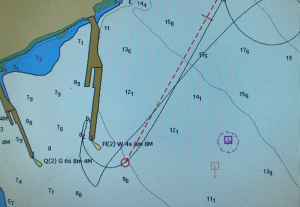The Charity
Aviation
Maritime
M2062

Initial Report
Our reporter, a passenger ferry captain, writes: “As per the timetable, we arrived at the standby location for the port at the required time. It was daylight, with good visibility and a stiff wind. We worked, as usual, on the pre-arrival checks and verifications as we closed on the berth. When I called the port per the pre-arrival checklist, I was informed that a large passenger liner had just let go and that I might have to ‘slow her up’ (referring to my vessel). However, given the proximity to the berth, the other boat and the increasingly confined waters, it was clear that I would have to lose speed quicker than I safely could. So, I had to opt for a rapid turn upwind (to avoid being set onto the nearby lee shore). I continued my turn and completed a 360, and during this time, the passenger liner was clear of the port and the berth we were aiming for. Our distance from the breakwater was approximately 3 cables when we started the turn.
For each port of arrival, we plan two abort positions. We had passed the first, where ‘Standby’ is rung on, the crew called to stations, pitch response is verified, and hand steering is engaged. We had not yet reached the second abort position (approximately four cables from the first), so a direct abort was still viable.
Shortly after passing the first abort and confirming the items mentioned, I called the harbour for permission to continue into the berth. I was given the all-clear whilst being advised of a departing cruise ship that might be leaving. The operator told me I “might want to slow her up a bit”, but it was now clear to me that I would need to abort the arrival to avoid a close-quarters situation with the cruise vessel, which was manoeuvring off her berth. Given the proximity of the lee shore to starboard, I elected to turn to port/upwind and gain distance from the shore, together with slackening speed to a minimum.
With the above avoidance measures well underway and having the desired effect, I communicated with the cruise vessel to establish which general direction they intended to take upon clearing the harbour to allow me to plan the rest of my manoeuvre and not result in additional unnecessary risk. With them advising a course to the east initially before turning to the north, I elected to complete a full 360, allowing time and space for the cruise ship to exit the immediate harbour area and for me to generally pick up the standard approach to our berth for arrival.
The main hazards were the proximity of the lee shore, with easterly winds, something that is factored into the passage plan to allow extra room, including the shoaling waters to the south of the berth; this knowledge allowed me to decide on early, positive and bold avoidance measures quickly, rather than allowing the risk to increase by proceeding onwards, even at a reduced speed, and allowing an unnecessary close quarters situation to develop.
As my vessel is on a timetabled service, we arrive and leave at the same time every day, weather permitting. Despite this, the cruise ship was allowed a departure that directly clashed with our arrival. A clash in movements such as this should have been avoided with a simple telephone call or email. After that, we could have timed our arrival later, thus preventing the situation above entirely.
It’s worth noting that the bridge team worked very well together in the initial arrival, the abort actions, and the passage/arrival resumption and subsequent safe berthing.
CHIRP Comment
The ferry traded time for space and safe water and avoided a close-quarters situation. This was the correct course of action. Readers are encouraged to compare this with report M2036, published in our last edition of FEEDBACK, which highlights the perils of taking the opposite approach.
Port authorities are responsible for managing vessel traffic, and they would have been aware of the ferry’s scheduled arrival time. Cruise vessels too operate to an itinerary but better co-ordination between the port and the cruise ship would have avoided this incident. This suggests either a breakdown in communication or the ferry’s arrival was not correctly considered when the cruise ship planned its departure time. Radio procedure by the port authority was also ambiguous: was “You might want to slow up” a direction, or a recommendation?
In smaller ports, particularly those which are not staffed 24 hours a day, publish notices to mariners directing certain sizes or categories of vessels to broadcast their arrival and departure on the port’s VHF working channel. This alerts other vessels of traffic in their vicinity and allows them to co-ordinate with each other. CHIRP encourages small ports to consider whether such a scheme would be appropriate in their harbour.
Key Issues relating to this report
Local Practices- Port management must not leave marine operations to chance. Establish clear safety risk measures, and define procedures to clearly understand what is required for arriving and departing vessels at this port.
Communications- Clear communications from the port authority, which prioritises incoming and outgoing vessel traffic, should be established, especially in ports with limited room to manoeuvre.







